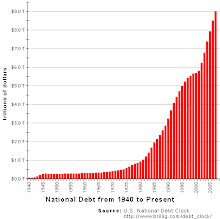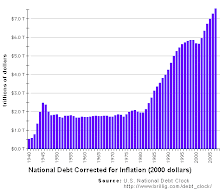Unfortunately, the baby boom generation – my generation – may not be remembered so fondly. An appropriate description for those of us born between 1946 and 1964 might be “The Most Selfish Generation.” I say this because of the wreckless fiscal irresponsibility we have demonstrated over the past 31 years.
Take a look at the red graph below.

At the end of 1980, the U.S. public debt was less than 1 trillion dollars. That means from the creation of this nation through 1980, the entire net accumulated amount of money borrowed by the U.S. federal government was less that 1 trillion dollars.
In 1981, about the time that baby boomers became leaders in both the public and private sectors, public policies were implemented that have led to a current public debt that exceeds 15 trillion dollars. So in the past 31 years, while baby boomers have been running things, the U.S. public debt has increased by more than 14 trillion dollars. In other words, over the past three decades, the United States has consumed 14 trillion dollars of government services we have not paid for and that we will pass to future generations.
For those of you who were born after 1964, I have two words for you …. You’re welcome. …. 15 trillion dollars of debt (and still counting) … that’s our gift to future generations.
To be fair, money borrowed today does not have the same purchasing power as the dollars of the past. So let’s take a look at the purple illustration below.

When the public debt is adjusted for inflation, the diagram illustrates my case even better. In the first 200 years of U.S. history, the federal government paid its bills (for the most part). In some years we ran modest deficits (you can see the big bump to pay for World War II), but we usually paid our bills. This changed in 1981 when taxes were cut under the leadership of President Ronald Reagan, but there was NOT a corresponding decrease in government services. The ultimate irony is that in his 1981 inaugural address, President Reagan warned of the dangers of public debt, saying:
For decades, we have piled deficit upon deficit, mortgaging our future and our children's future for the temporary convenience of the present. To continue this long trend is to guarantee tremendous social, cultural, political, and economic upheavals.
Yet, Reagan helped create a culture of hypocrisy in which we complain about public debt, but seem to continually demand further tax cuts while steadfastly refusing to sacrifice any of the government benefits we expect.
The military conflicts of the past decade in Iraq and Afghanistan are the first time in U.S. history that we have cut taxes in a time of war. When men and women of mostly younger generations are sacrificing their lives for our country, we – the baby boomers – refuse even to pay the financial costs of supporting them – choosing instead to pass the costs to our children, grandchildren, and future generations. And let’s not forget that while reducing federal government revenues through the Bush tax cuts of 2001 and 2003, we also greatly expanded the size and scope of the U.S. federal government through the implementation of Medicare Part D which subsidizes the costs of prescription medications.

The diagram above illustrates the U.S. public debt as a percentage of gross domestic product. It shows our debt in relation to our income. Richer countries and richer people can afford more debt than poorer ones. But even by this measure, the wrecklessness of baby boomer public policies is evident.
You may notice in this graph, as in the previous two illustrations, that there is a decrease in the U.S. public debt in the late 1990s. It is natural and normal for there to be ups and downs in economic activity over time. Economists call this the business cycle. And the surpluses of the late 1990s correspond to being in a properous part of the business cycle. But these budget surpluses were primarily the result of the short-term willingness of Congress to impose on itself pay-as-you-go (PAYGO) rules that require any new spending to be funded by increased revenues or offset by reductions in other expenditures. But as yet another example of baby-boomer selfishness, these rules were abandoned in 2001 (fiscal year 2002) to allow for the popular tax cuts and the subsequent increases in government expenditures.

A June 10, 2009 New York Times article, "America's Sea of Red Ink was Years in the Making," and an accompanying diagram explain and illustrate how U.S. budget surpluses became deficits. The major components and their relative magnitudes are illustrated by the downward arrows. The contributing factors were:
(1) The early 2000s recession caused reduced tax revenues and increased government assistance (- $291 billion a year)
(2) The Bush policies (tax cuts, Iraq war, Medicare prescription drugs) (- $673 billion)
(3) The late 2000s recession (Dec. 2007-2009) also reduced tax revenues and increased government assistance (- $479 billion)
(4) Wall Street Bailouts (begun under Bush & continued under Obama) (-$185 billion)
(5) Other programs supported by both the Bush & Obama administrations, such as the Iraq war and a patch for the alternative minimum tax (- $232 billion)
(6) Stimulus spending (- $145 billion), and
(7) Other Obama programs (- $56 billion).

A July 2011 diagram (above) from The New York Times series, "Charting the American Debt Crisis," shows (on the right) how much of the $14.3 trillion debt (at the time) was accumulated under each U.S. President and (on the left) who holds the debt.
This should NOT be a partisan issue. At a fiscal forum at Jacksonville University on January 26, 2012, former Republican Senator Mel Martinez joined JU alumnus David Walker, the former Comptroller General of the United States and the founder and CEO of the Comeback America Initiative; and Robert Bixby, the executive director of the Concord Coalition; to convey a similar message: federal revenues [as a percentage of gross domestic product (GDP)] are the lowest they have been and expenditures (as a percentage of GDP) are the highest since 1950. (See the diagram below.) Collectively, U.S. citizens need to pay more in taxes and receive fewer government benefits. But that is NOT a message that we want to hear.

And it is worth noting that most of those who are raising the alarm about this debt issue, are not proposing solutions that involve sacrifice by baby boomers. Indeed the refrain is that those of us at or near retirement will not receive any reduced benefits from Social Security or Medicare. The proposed reforms will reduce benefits for younger people.
Once again, I say to people born after 1964 … You’re welcome!
There is one notable exception among the voices for fiscal reform who offers a chance at redemption for baby boomers, if you want to call it that.
David Stockman, President Ronald Reagan’s budget director, advocates a one-time surcharge on the wealthy. He explains the idea in an interview he did for 60 Minutes in October 2010. Click the link above to find the interview or simply search for “David Stockman 60 Minutes.”












